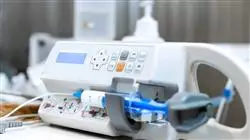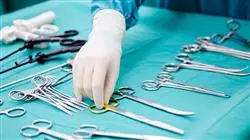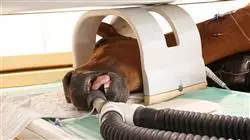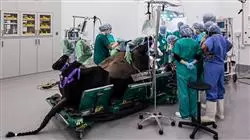University certificate
The world's largest faculty of veterinary medicine”
Description
Veterinary Anesthesiology in Large Animals has undergone great advances in recent years. Get up to speed and incorporate the latest scientific developments into your daily practice by taking this comprehensive professional master’s degree from TECH"

In the last 20 years, Veterinary Anesthesia in Large Animals has experienced significant advances thanks to the introduction of new techniques and drugs, as well as the development of monitors and specialized anesthetic machines.
The introduction of novel surgical techniques has resulted in the need to develop new anesthetic protocols. There is a growing concern about the impact of anesthesia and analgesia on animal welfare and the final outcome of surgical procedures.
The professional master’s degree in Veterinary Anesthesiology in Large Animals is programmed as a response to the need of clinical veterinarians to expand their expertise in anesthetic and analgesic protocols and techniques in large animals.
The teaching team for this professional master’s degree is made up of professionals specialized in Veterinary Anesthesiology in Large Animals, with extensive experience in teaching, both in undergraduate and graduate programs, most of them being university professors and graduates. These professors are practicing anesthesiologists at leading veterinary centers and directors or participants in various research projects, so that in addition to teaching and clinical work they also carry out research activities.
The topics covered in this professional master’s degree have been selected with the aim of offering a complete specialization in anesthesia, so that the student builds specific knowledge to safely address any situation that requires general or locoregional anesthesia and analgesia in ruminants, swine, camelids and equids.
At present, one of the issues that affects continuous postgraduate development is the reconciliation of work and personal life. Modern professional demands make it difficult to provide quality, specialized, on-site education, so the online format will allow students to combine this course with their daily professional practice.
The training offered by this program is aimed at experienced clinical veterinarians who wish to specialize in the field of Veterinary Anesthesiology in Large Animals in order to provide comprehensive and high-quality care to clients, meeting the current demands for highly specialized training in veterinary medicine.
You will explore and broaden your knowledge of the vital signs that must be monitored during general anesthesia or sedation of the equine patient"
This professional master’s degree in Veterinary Anesthesiology in Large Animals contains the most complete and up-to-date scientific program on the market. The most important features include:
- The latest technology in online teaching software
- Intensely visual teaching system, supported by graphic and schematic contents, easy to assimilate and understand
- Case studies presented by practising experts
- State-of-the-art interactive video systems
- Teaching supported by telepractice
- Continuous updating and recycling systems
- Autonomous learning: full compatibility with other occupations
- Practical exercises for self-evaluation and learning verification
- Support groups and educational synergies: questions to the expert, debate and knowledge forums
- Communication with the teacher and work for individual reflection
- Content that is accessible from any fixed or portable device with an Internet connection
- Supplementary documentation databases which are permanently available, even after the program
A professional master’s degree that will enable you to work as an anesthesiologist in veterinary medicine, with the competence of a high-level professional"
The teaching team is made up of professionals from different fields within this specialism. In this way, TECH ensures that it delivers educational results in line with its objectives. A multidisciplinary team of professionals, trained and experienced in different environments, who will develop the theoretical knowledge in an efficient way, but above all, they will bring their practical knowledge from their own experience to the program: one of the differential qualities of this training.
This mastery of the subject is complemented by the effectiveness of the methodological design used in this professional master’s degree in Veterinary Anesthesiology in Large Animals. Developed by a multidisciplinary team of e-Learning experts, it integrates the latest advances in educational technology. Students will be able to study with a range of convenient and versatile multimedia tools that will give them the operability they need while specializing in the subject.
The design of this program is based on Problem-Based Learning: an approach that views learning as a highly practical process. To achieve this remotely, TECH will use telepractice: with the help of an innovative, interactive video system, and Learning from an Expert, students will be able to acquire the knowledge as if they were facing the case they are learning in real time. A concept that will allow students to integrate and memorize what they have learnt in a more realistic and permanent way.
You will have the experience of expert professionals who will contribute their experience in this area to the program, making this course a unique opportunity for professional growth"

With a methodological design based on proven teaching techniques, this training will take you through different teaching approaches to allow you to learn in a dynamic and effective way”
Objectives
The objective of this professional master’s degree is to create highly qualified professionals. The aim is focused on helping professionals reach a much greater level of expertise and control. A goal that can be achieved in only in a few months, with a high intensity and precision program.

If your objective is to broaden your skills set to include new paths for success and development: this is the program for you: a professional master’s degree that aspires to excellence"
General Objectives
- Examine the anatomy and physiology of the cardiovascular system and the functioning of the respiratory system
- Establish the normal functioning of the digestive and renal systems
- Develop specialized knowledge on the functioning of the nervous system and its response to anesthesia
- Analyze the unique needs of the different species (ruminants, swine, camelids and equids)
- Examine the requirements of a pre-anesthetic evaluation and develop expertise in interpreting anesthetic risk
- Establish the pre-anesthetic preparation required for large animals
- Analyze the pharmacological properties of injectable drugs
- Determine available sedative and tranquilizing drugs
- Deepen your knowledge of the available protocols for deep sedation
- Gain advanced knowledge of pharmacology and clinical maneuvers in the induction and intubation period in small and large ruminants, swine and camelids
- Provide safe options for current and new combinations of these agents to perform effective and safe induction of general anesthesia in the equine patient
- Detail the procedures for endotracheal intubation in the equine patient
- Examine the main physiological, anatomical and clinical needs related to the different types of decubitus and limb positioning of the equine patient
- Determine the components and operation of anesthetic machines, respiratory systems, oxygen delivery systems and artificial ventilation
- Generate specialized knowledge of the pharmacology of halogenated inhalation anesthetics, injectable anesthetics, sedative adjuvants, as well as the most recent TIVA and PIVA techniques described for ruminants, swine and camelids, and for equine species
- Develop advanced knowledge on mechanical ventilation in order to recognize the need for mechanical ventilation and the most effective and safe Settings for ruminants, swine and camelids, as well as for equine species
- Determine the pharmacology and clinical application of neuromuscular blocking agents
- Build specialist knowledge on the anesthetic recovery phase in ruminants, swine, camelids and equine species
- Determine the vital importance of the correct use of the anesthetic records during general anesthesia
- Examine and deepen knowledge related to the vital signs that should be monitored during general anesthesia or sedation of the equine patient
- Establish the technical features of the main monitoring equipment used in the equine patient
- Build knowledge of the main special monitoring requirements in ruminants, swine and camelids
- Analyze the pathophysiological principles governing pain processes
- Determine the features and correct use correct of pain scales specific to the equine species
- Generate specialized knowledge of the pharmacology of the main families of analgesic agents
- To examine the special pharmacological qualities of analgesic agents in ruminants, swine and camelids
- Examine the anatomy relevant to the locoregional disease techniques to be performed
- Generate specialized knowledge on the clinical pharmacology of the local anesthetics to be used
- Determine the equipment necessary to perform the different loco-regional techniques
- Detail how to perform the different loco-regional techniques in large ruminants, small ruminants, swine and camelids
- Establish how to perform the different loco-regional techniques on horses
- Identify, prevent and resolve complications during the perianesthetic period in the horse
- Establish the appropriate clinical approach to cardiorespiratory resuscitation in the adult horse and neonatal foal
- Identify, prevent and resolve complications during the perianesthesia period in small and large ruminants, swine and camelids
- Establish the bases of body fluid and electrolyte physiology in the equine patient
- Determine the acid-base balance and interpret the most common alterations in equine patients
- Examine the skills and knowledge required for venous catheterization in the equine patient
- Establish the clinical and laboratory parameters important for monitoring of fluid therapy in the equine patient
- Establish the special physiological considerations related to fluid therapy in ruminants, swine and camelids
- Examine the main characteristics of crystalloid and colloid solutions frequently used in ruminants, swine and camelids
- Generate specialized knowledge related to therapeutic applications of fluid therapy in ruminants, swine and camelids
- Analyze the types of fluids available for the equine patient
- Know the main characteristics of the most frequent standing procedures performed under sedation
- Detail the most pertinent points on anesthetic management of the most common diagnostic and therapeutic procedures
- Generate specialized knowledge for the correct anesthetic management of animals intended for human consumption
- Become an expert on the legislation related animals for human consumption as well as experimental animals
- Detail the main logistical, pharmacological and clinical requirements for the correct anesthetic management of wild animals
- To specify the most characteristic special anesthetic management considerations for the most frequent diagnostic and therapeutic procedures in foals
- Perform euthanasia protocols that respect the physical and mental well-being of the horse
Specific Objectives
Module 1. Physiology Applied to Anesthesia in Large Animals
- Examine the special anatomical and physiological features of large and small ruminants relevant to the design of a safe anesthetic protocol in these species
- List the special anatomical and physiological features of swine and Camelids relevant to the design of a safe anesthetic protocol in these species
- Establish the hormonal and neuronal mechanisms involved in the control of the cardiovascular system
- List processes related to ventilation and gas exchange
- Analyze the clinical implications of respiratory alterations in anesthetized patients
- Determine the normal anatomy and physiology of the digestive system and the consequences of anesthesia on it
- Establish the excretion and hormonal processes related to the renal system
- Generate specialized knowledge on the anatomy and physiology of the nervous system
- Analyze the alterations produced by anesthetic drugs in the nervous system
Module 2. Evaluation, Preanesthetic Preparation and Sedation for Large Animals
- Determine the physical examination and common findings in the equine pre-anesthetic evaluation
- Consolidate the basics of pre-anesthetic laboratory evaluation
- Analyze, identify and interpret the patient’s anesthetic risk
- Establish the necessary actions in the preparation of the patient for anesthesia
- Detail the special pharmacological considerations for the main sedative drugs in ruminants, swine and camelids
- Know the pharmacological properties and clinical implications of sedative and tranquilizing drugs
- Establish the most common standing procedures and protocols in the equine patient
Module 3. Induction of General Anesthesia in Large Animals
- Build specialist knowledge on the pharmacology of dissociative agents and barbiturates given the side effects and the main contraindications for their administration
- Examine the pharmacology of propofol, alfaxalone and etomidate, given the side effects and major contraindications for their administration
- Develop advanced knowledge of the pharmacology of muscle relaxants such as benzodiazepines and guaifenesin
- Examine the anatomical, physiological and pharmacological considerations necessary to perform effective and safe induction of general anesthesia and endotracheal intubation in small and large ruminates, swine and camelids
- Determine the physiological and anatomical considerations necessary to perform an effective and safe take-down for patients and staff in the equine population
Module 4. General Anesthesia and Equipment in Large Animals
- Analyze the most frequent problems in the anesthetic machine and circular circuit, in order to identify and solve them
- Know and understand the operation of oxygen delivery systems and artificial ventilation during the general anesthesia of large animals.
- Know the pharmacology of halogenated inhalation anesthetics and their adverse effects in large animals
- Explore injectable sedative and hypnotic agents that can be used as adjuvants or as general anesthetics, as well as the latest techniques prescribed for PIVA and TIVA in equines
- Detail the techniques of general anesthesia, both by inhalation and injectable, prescribed in large and small ruminants, swine and camelids
- Recognize the need for mechanical ventilation during anesthesia, know the positive and negative consequences of mechanical ventilation, as well as understanding the appropriate ventilatory parameters for its safe application
- Broaden your knowledge of specific special features of mechanical ventilation in large and small ruminants, swine and camelids
- Broaden your knowledge of the relevant anesthetic recovery considerations in large and small ruminants, swine and camelids
Module 5. Monitoring in Large Animals
- Detail the correct and regular use of the anesthetic record during general anesthesia
- Determine the importance and the most characteristic clinical signs of anesthetic depth monitoring in the equine patient
- Analyze the importance and main technical considerations relating to the monitoring of cardiovascular and hemodynamic rates
- Detail the leading role of arterial blood gases in the clinical monitoring of the equine patient during general anesthesia
- Detail the special monitoring considerations for other types of vital parameters, such as glucose, lactate, temperature or the degree of neuromuscular blockade
- Examine the main special anesthetic monitoring considerations in other species such as ruminants, swine and camelids
Module 6. Analgesia in Large Animals
- Examine the definition of pain, as well as the different types of pain in relation to their pathophysiology and their evolution in time
- Determine the main physiological components associated with pain sensation
- Generate specialized knowledge relating to the nociception pathway
- Determine the main pathophysiological consequences of untreated pain
- Analyze theories on the use of pain scales in the equine patient
- Gain advanced knowledge of the pharmacology of opioids, NSAIDs, alpha-2 agonist agents, ketamine, lidocaine and other co- analgesic drugs
- Establish the main side effects of opioids, NSAIDs, alpha-2 agonist agents, ketamine, lidocaine and other co- analgesic drugs
- Determine the main contraindications to the administration of opioids, NSAIDs, alpha-2 agonist agents, ketamine, lidocaine and other co- analgesic drugs
- Examine the clinical uses of opioids, NSAIDs, alpha-2 agonist agents, ketamine, lidocaine, and other co- analgesic drugs
Module 7. Locoregional Anesthesia in Large Animals
- Determine the drugs to be administered
- Establish the equipment to be used
- Examine the anatomy of the head in relation to the nerve blocks performed
- Generate specialized knowledge on local head, forelimb and hind limb techniques
- Examine the anatomy of the forelimb and hind limb in relation to nerve blocks
- Detail the anatomy of the abdomen relevant to the nerve blocks performed
- Generate advanced knowledge on local abdominal techniques
- Examine the anatomy of the vertebral canal
- Detail the epidural technique
- Determine the main loco-regional techniques in other large animal species
Module 8. Anesthetic Complications and Cardiopulmonary Resuscitation
- Know the published studies on mortality and perianesthetic morbidity in horses
- Know the risk factors and causes for perianesthetic mortality
- Identify, anticipate and resolve complications that occur in the premedication phase
- Identify, anticipate and resolve complications that occur during the induction phase
- Identify, anticipate and resolve complications that occur in the maintenance phase
- Identify, anticipate and resolve complications that occur in the recovery and postoperative phase
- Early recognition of life-threatening cardiorespiratory emergencies in horses
- Develop effective cardiorespiratory resuscitation protocols
- Know the complications relating to improper positioning of the ruminant, swine or camelid patient
- Recognize the main cardiovascular complications in ruminants, swine and camelids
- Study the complications associated with the gastrointestinal system in camelids
- Recognize complications associated with intravenous catheter placement in ruminants, swine and camelids
- Broaden your knowledge of the pathophysiology of malignant hyperthermia
- Identify the complications that can occur during anesthetic recovery in ruminants, swine and camelids
Module 9. Fluid Therapy in Large Animals
- Detail the physiology and movement of bodily water
- Deepen your knowledge of the physiology and alterations of the most important electrolytes
- Determine the acid-base balance and its regulation
- Interpret pH alterations
- Reinforce the important factors for catheter and catheterization site selection
- Detail the most frequent complications of venous catheterization
- Analyze the most frequent crystalloid fluids
- Detail the properties of blood derivatives and know their complications
- Deepen your knowledge of the special physiological features of ruminants, swine and camelids in relation to fluid therapy
- Establish the properties of the isotonic, hypotonic and hypertonic crystalloid solutions most frequently used for ruminants, swine and camelids
Module 10. Cases and Special Clinical Situations for Large Animals
- Gain specialized knowledge on the most frequent surgical and imaging procedures
- Establish the most appropriate protocols according to the procedure to be performed
- Detail the main differences in foal anesthesia in comparison to adults
- Know the risk factors and complications for colic anesthesia in order to adapt the anesthetic protocol
- Detail the physiological aspects to be taken into account for anesthesia in geriatric horses
- Deepen your knowledge of anesthetic management of the main diagnostic and therapeutic procedures in large and small ruminants
- Detail the anesthetic management of ruminant adnexal organs such as horns, hooves or tails
- Master the features of anesthesia in swine transplantation models, as well as for laparoscopy in experimental swine
- Establish basic characteristics of field anesthesia in pigs and castration of piglets
- Determine the basic principles of field anesthesia in camelids
- Define the main behavioral, physiological and anatomical characteristics of donkeys and mules
- Deepen your knowledge of the pharmacology of anesthetic and analgesic agents in donkeys and mules
- Broaden your knowledge of the logistics and pharmacological methods most appropriate for the capture and handling of wild species
- Master sedation and field anesthesia protocols for wild ruminants
- Determine sedation and field anesthesia protocols for wild swine
- Detail sedation and field anesthesia protocols for wild camelids

You will acquire the necessary knowledge to be able to carry out a preliminary anesthetic assessment"
Professional Master's Degree in Veterinary Anesthesiology in Major Species</h1
Part of the success in surgical procedures in the veterinary field is linked to a correct anesthesia and adjuvant monitoring. This does not seem to mean major inconvenience when we talk about conventional pets: canines, felines or birds, but before other species of considerable size such as equines, camelids, swine or ruminants, expectations require new strategies and skills. For this reason, TECH Global University presents the Professional Master's Degree in Veterinary Anesthesiology in Major Species, a resizing of the clinical animal panorama in its most particular aspects, from the physiology of the cardiovascular system in the horse to the application of euthanasia protocols. Do you want to deepen your knowledge in the use of ketamine and lidocaine, learn how to accompany a laparoscopy or master intubation techniques for large and small camelids? In this postgraduate course you will find this and much more. Thanks to our methodology of 100% virtual classes combined with innovative educational models, not only will you be able to graduate without leaving home, but you will do it regulating your own schedule and accompanied by an extraordinary faculty. TECH is everything you were looking for.
Specialize in anesthesiology for larger species
.
Whether in minimally invasive procedures or in surgeries of complex intervention, anesthesia must always go through three phases: before, during, after, plus a fourth one that encompasses the perioperative complications present in the course of the surgical work. The latter are avoidable with an optimal assessment of the patient's nociceptive condition, the correct choice of anesthetic and analgesic drugs and, of course, constant monitoring to avoid arrhythmias, hypoxemia, hypercapnia, among others. Thanks to our comprehensive Professional Master's Degree, you will acquire sufficient skills to carry out an optimal anesthetic control of the animal. There are a total of ten modules in which you will learn sedation, analgesia, locoregional anesthesia, cardiopulmonary resuscitation, fluid therapy, special clinical situations, among other useful topics. At TECH we take professional training to another level, using the best educational technology and the most qualified teaching teams, which is why we are ranked as the best online university in the world. Enroll now and be part of a unique experience.







